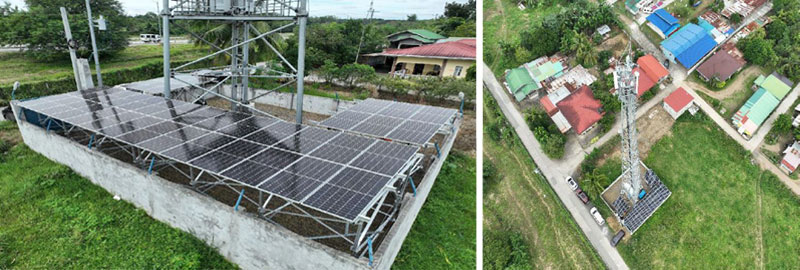PLDT wireless unit Smart Communications (Smart) is expanding the use of solar energy for its cell sites using solar panels with battery storage systems as Smart pushes to operate a greener network and integrate sustainable solutions in its daily operations.
“The ‘Solar and Energy Storage as a Service’ (SESaaS) model will improve availability of power supply especially in areas where there is limited or no commercial power allowing us to serve more remote communities. This will also reduce Smart’s use of power from carbon sources. Once fully implemented, we’re looking at a reduction of as much as 88% in greenhouse gas emissions in off-grid sites,” said Eric Santiago, FVP and Network Head at PLDT and Smart.
Smart has completed proofs of concept (POC) for four power source types – Good Grid, Poor Grid, Bad Grid and Off-Grid – in two locations. The first one is an off-grid site in Palawan, where the installation successfully energized the tower the entire day. The second location is a commercial grid-powered site along STAR Tollway. The facility proved it can seamlessly switch from being energized by the commercial grid, to being electrified by surplus power stored in batteries.
Based on the POCs, Smart sees opportunities for cost efficiencies. This will also enable Smart to extend mobile signal availability to customers in remote areas not connected to the electricity grid. It can also limit dependence on diesel generators in case of power failures and emergency situations.
This best illustrates the ‘Solar Energy as a Service’ business model, in which the chosen supplier will install photovoltaic cells and a battery storage system in Smart cell sites. In facilities connected to the commercial power grid, the installation will help power the assets during peak hours and store surplus energy during off-peak hours, for future use.
Given the limited supply of non-conventional power from the market, Smart continues to search for alternative power sources particularly renewables. The PLDT group continues to test and adopt environmentally friendly technologies as part of pursuing its decarbonization roadmap where it targets to reduce Scopes 1 and 2 GHG emissions by 40% by year 2030.
President and CEO Alfredo Panlilio has identified sustainability as one of the key pillars underpinning the PLDT Group strategy and continues to advocate the expanded use of renewable energy and green technologies in daily operations.
These efforts underscore PLDT and Smart’s commitment to the United Nations Sustainable Development Goals particularly SDG 9 on Sustainable Industrialization and Innovation, SDG 12 on Responsible Consumption and Production and SDG 13 on Climate Action.
Liked this post? Follow SwirlingOverCoffee on Facebook, YouTube, and Instagram.


